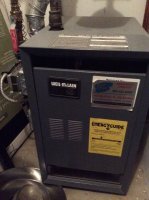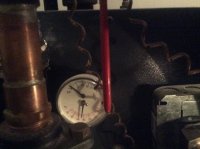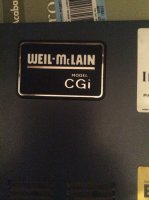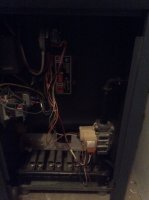A bit of terminology: "Furnace" for most of the US is reserved for ducted hot air systems. What you have is a hydronic boiler (as distinct from a steam boiler.)
If the pressure is as low as indicated on the gauge there is probably a bit of sizzle pop & bang "kettling" at the beginning of a burn cycle. Could that be what is meant by "...clicking a lot..."??
There may or may not be air in the system needing to be bled, but the solution to low pressure is adding more water to the system. Most are plumbed with an "auto fill" valve, sometimes called a "pressure reducing valve" between the potable plumbing and the system. Those types of valves automatically add water until the system pressure reaches their pre-set adjusted level. Usually in-line with the auto-fill is a valve for isolating it completely from the potable water plumbing (necessary for serviceing the heating system). If the isolating valve is closed, the auto-fill can't do it's job, and if there are any leaks in the system, even tiny leaks, the pressure will drop over time.
If it's a mulit-story house with the boiler in the basement, and the pressure drops too far, the top of the system could be at negative pressure relative to the room air pressure, which can introduce air into that zone, which would limit and eventually stop flow in that loop.
So, first order of business is to check the pressure at the boiler, and raise it if need be. There is usually a drain port valve with a regular garden hose type connection either on the boiler or on the near-boiler plumbing. A
cheap $10 hose pressure gauge is good enough for sanity-checking the boiler's gauge. For the really cheap gauges the first unmarked tick is usually 10 psi, and the system pressure needs to be above that tick to limit the kettling, but unless it's a particularly tall house it doesn't usually need to be over 15psi to reliably get the water to the top of the system under positive pressure. So shoot for somewhere in the middle, between 10-20psi. Keep it well UNDER 20psi, or there's a chance of overpressure tripping the pressure relief valve at the middle or end of a burn cycle. (Most boilers are shipped with 30psi relief valves.)
Ideally the expansion tank will have been preset to something like 12-15 psi, but we'll address that later, after you've fixed any pressure or flow issues. If the pressure relief isn't opening up and dumping hot water out of the system, it's probably "close enough", but it's good to check the preset on bladder type expansion tanks at least once every handful of years.





